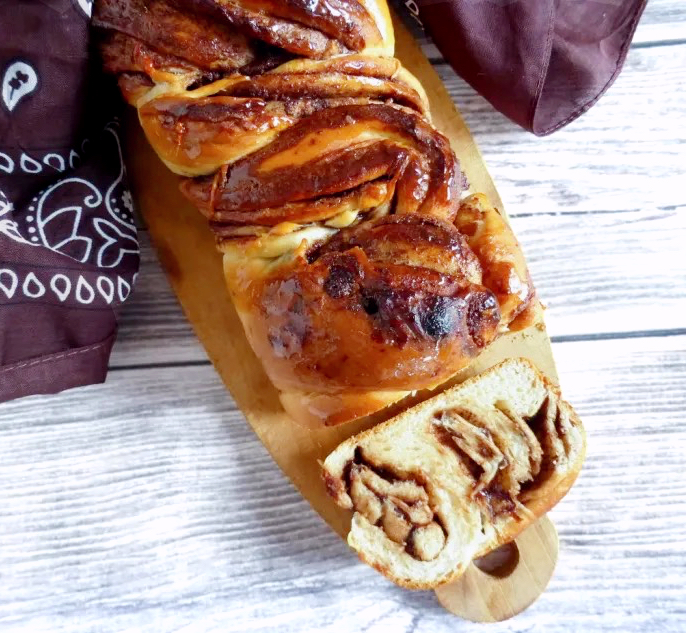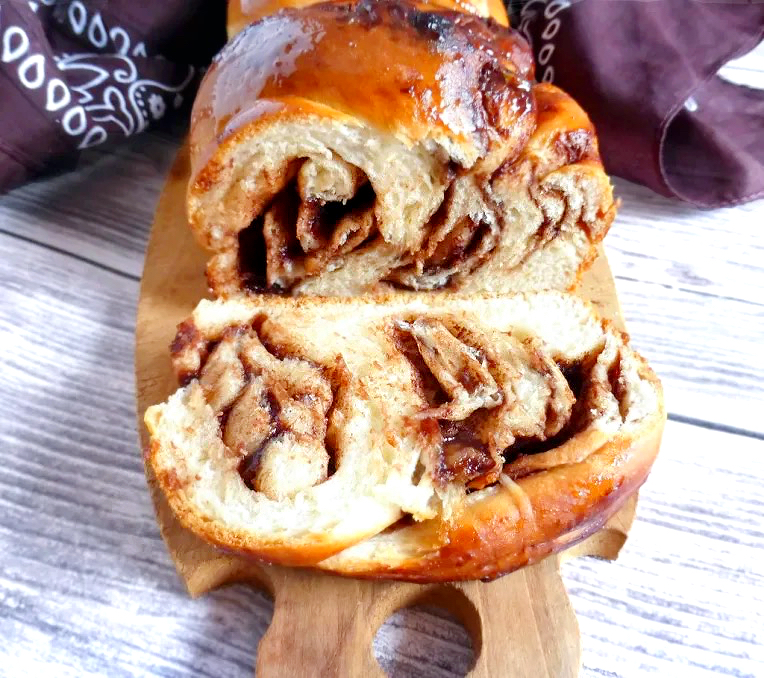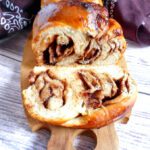Spelt Nutella Babka
This spelt Nutella babka is soft, mildly sweet cinnamon infused bread with rich, velvety Nutella. What a combo. As always, I try to make my recipes as inclusive as possible, and this one is no exception. You can prepare the dough in a bread machine or stand mixer, and use either spelt flour or regular.
This homemade spelt Nutella babka originally appeared on my first blog, The Culinary Jumble. The recipe was amended to include spelt flour and the content of the post has been updated.
|
|
| Spelt Nutella babka |
| What is babka? |
| The classic babka swirl |
| Modern variations |
| More sweet bread recipes |
Spelt Nutella babka
This soft Nutella babka is a modern take on a timeless favourite. Made with milk, butter and egg, the brioche-style dough is rich yet tender; perfect for holding swirls of chocolatey Nutella. I use spelt flour in my dough, which gives the bread a slightly nuttier flavour and a softer, more delicate crumb.
It’s indulgent without being over the top. Just the way babka should be. A light brush of honey over the warm loaf adds a gentle shine and just the right hint of sweetness
What is a babka?
Babka is a brioche-style bread enriched with eggs and butter, giving it a soft, tender crumb and a rich, almost cake-like flavour. It’s one of those glorious bakes that can’t be pinned down. Served as both breakfast and dessert, sweet but still undeniably a bread. Is it a cake? A pastry? A bread with ambitions? Maybe all of the above. But really, who needs to label it?
The roots of babka trace back to Eastern Europe in the early 19th century, where it was born out of both necessity and creativity. Traditionally, leftover challah dough—often made for Sabbath—was repurposed by rolling it up with sweet fillings like cinnamon, jam, or even cheese. The dough was then twisted into a loaf shape, giving babka its iconic swirls and marbled interior. While it was a familiar treat in Jewish communities across Poland and Ukraine, it remained relatively unknown outside of those circles for many decades.
It wasn’t until the mid-20th century that babka began to find a wider audience. Jewish immigrants brought their family recipes to the United States, where European-style bakeries in cities like New York started to offer babka to a broader clientele. Over time, the fillings evolved from traditional cinnamon and dried fruit to modern variations like Nutella, chocolate, and even savoury twists. Despite the changing flavours, the essence of babka has stayed the same: comfort, tradition, and a generous swirl of something sweet.
The classic babka swirl
One of babka’s most recognisable features is that beautiful, twisted swirl running through the loaf. It’s not just for looks; it helps distribute the filling throughout the bread, giving you little pockets of flavour in every bite. And while it may look impressive (and even a bit intimidating), the technique is actually quite straightforward.
Once your dough has risen and been rolled out into a rectangle, you simply spread your chosen filling evenly over the surface, leaving a small border around the edges. Then roll it up tightly, just like you would for cinnamon rolls, starting from the long edge to create a neat log. At this stage, you can pop it in the fridge for 10–15 minutes if the filling is very soft, as this makes the next step less messy.
Now for the twist: use a sharp knife to slice the log cleanly down the middle lengthways, exposing the layers of dough and filling. With the cut sides facing up, cross the two halves over each other in a simple twist, keeping that swirled interior visible. Then carefully lift it into a loaf tin and let it rise again before baking. It is a little messy, a bit rustic, and that’s all part of the charm. No two babkas ever look quite the same, and that’s exactly how it should be.
Modern variations
Although babka has indeed moved with the times, now including Nutella and many other indulgent fillings, the basic dough ingredients and method have changed very little. The rich, pillowy dough remains the same. What varies is how you choose to dress it up.
Other popular fillings include spiced apple, cinnamon-sugar, crushed nuts (especially walnuts, pecans or hazelnuts), and dried fruits like raisins or apricots. Chocolate in all its forms is a firm favourite too: dark chocolate chunks, chocolate spread, or a cocoa-sugar mix with butter all work beautifully. For something a little different, try tahini and honey, lemon curd, or even a swirl of cream cheese and berries. The options are endless, which is part of babka’s charm.
As well as this spelt Nutella babka, I’ve also made a gorgeous raspberry babka, which features in my book, Baking with Spelt. It’s one of those bakes that invites creativity. You can easily adapt it to suit the seasons, your pantry, or whatever you happen to be craving.
Chocolate filled overnight buns
Homemade Nutella Babka
Ingredients
Dough (see note 1):
- 250ml (1 cup) milk
- 50g (3½ tbs) butter
- 1 egg (medium)
- 1 tsp vanilla
- 360-480g (3-4 cups) spelt flour (see note 2)
- 7g (2¼ tsp) dried yeast (see note 3)
- 3 tbsp brown sugar
- 1 tsp cinnamon
- 1 tsp sea salt
Additional Ingredients:
- Nutella (see note 4)
- honey (to brush over warm bread)
Instructions
DOUGH
Bread Machine:
- Add the milk, butter, and egg to your bread machine pan.
- Then add 450g (3⅔ cups) of flour, and the remaining ingredients. Take care to keep the yeast and salt separate as much as possible. Set your machine to make dough.
- On a well-floured surface (the dough will be sticky) work in just as much flour as you need to make a soft, pliable dough that’s still a little tacky.
Stand Mixer:
- Gently heat the milk in the microwave until just lukewarm (around 37–40°C / 100–105°F). Stir in the butter (it will soften nicely).
- Then add 360g (3 cups) of flour, and the remaining ingredients. Mix until combined.
- Gradually add extra flour as needed one tablespoon at a time, allowing it to incorporate fully before adding more. You may not need the full amount stated, or you could need more. Be careful not to add too much, as this will make the bread dense.
- After a few minutes, the dough will start to pull away from the sides of the bowl. You may notice your machine working a little harder (mine starts to make a clumping sound). The dough will still be sticky and will slip easily from the paddle.
- Using a spatula, scrape the dough from the paddle. Add a little more flour and continue kneading until the dough pulls completely away from the sides of the bowl and most of the bottom. It will no longer drip from the paddle but should come away easily when pulled. The dough should feel tacky, but not stick to your fingers.
- Cover the dough and leave it to proof in a warm place until it has doubled in size, usually 60–90 minutes.
- Knock back the dough on a lightly floured surface and form it into a rough ball.
For both methods:
- Pre-heat the oven to 185ºC (365ºF).
- Either prepare two smaller baking tins (9" x 5" / 23cm x 12cm) or one larger tin (13" x 4" / 33cm x 12cm) by greasing and/or lining with baking paper.
- If making two loaves, divide your dough into two (and repeat the following process for both).
- Roll the dough until it is fairly thin, and you are left with a large rectangle. The dough will bounce back so you may need to roll several times.
- Spread over as much Nutella as you like bearing in mind that the more there is, the trickier it is to handle. As you spread the Nutella out, leave around 1-2cm at the edges clear as this will make it easier to roll.
- Starting from the side nearest to you, carefully roll the dough over and continue until you are left with a large roll. Finish off with the seam facing down.
- Take a sharp knife or pizza cutter and cut right down the length of the roll so you are left with two pieces.
- Take one piece and lay it over the other to make an X. Then twist the two pieces of dough around each other, both at the top and bottom.
- Tuck the bottoms under on both sides, pushing the dough a little so that it is a bit thicker, and not so stretched out.
- Place the dough in your prepared pan(s), cover with a tea-towel, and leave for around 30 minutes.
- Bake for around 20 minutes until the bread is golden brown.
- Leave to cool for around five minutes, then brush honey over the top.
- Slice when the bread has cooled slightly but is still a little warm. Enjoy!
Notes
- I have made the dough using both a stand mixer and bread machine with identical results. I have not made the dough by hand, but I see no reason why you couldn't do so. The dough is enough to make 2 smaller babkas (9" x 5" / 23cm x 12cm) or one large one (13" x 4" / 33cm x 12cm).
- You can use spelt or regular flour for this recipe (just use the same amount).
- In Sweden we have something called dried yeast. It is used both in warm liquid to proof and also added directly to flour. I am aware that the US has two options for dried yeast, and I believe instant yeast is the most similar to our dried yeast.
- I didn't weigh out my Nutella - use as much as you need to get a good, even coverage.







